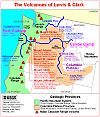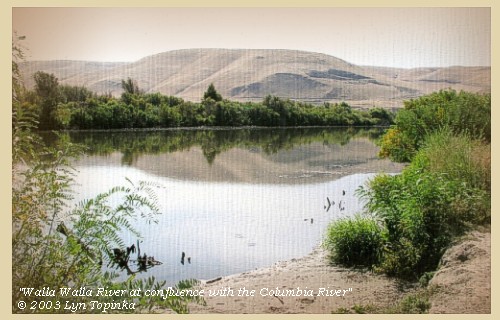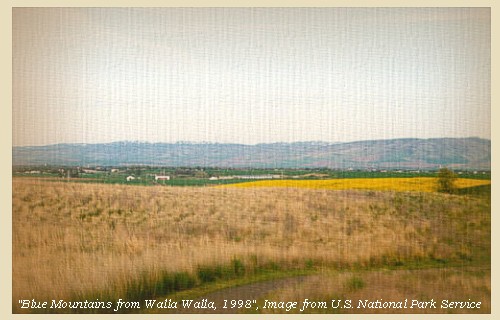The Volcanoes of
Lewis and Clark
Lewis and Clark
|
April 29, 1806 Up the Columbia - Walla Walla |
|
Home
The Volcanoes of Lewis and Clark Map of the Journey Volcanoes, Basalt Plateaus, Major Rivers, etc. The Volcanoes Mount Adams, Mount Hood, Mount Jefferson, Mount Rainier, and Mount St. Helens CALENDAR of the Journey October 1805 to June 1806 Along the Journey Pacific Northwest Maps - Columbia River, Volcanoes, Flood Basalts, Missoula Floods, Geology, etc. The Corps of Discovery The Journey of Lewis and Clark About the Reference Materials The Journals, Biddle/Allen, DeVoto, Gass, Moulton, Topo Maps, and others USGS Lewis and Clark Links Links to USGS Websites highlighting the Lewis and Clark Journey Resources Publications Referenced and Websites Visited |
PREVIOUS
April 23-28 Up the Columbia, Rock Creek to Walla Walla |
April 29
Up the Columbia River, Walla Walla Walla Walla River, Blue Mountains |
CONTINUE
April 30 Walla Walla Shortcut, Overland, Walla Walla to the Touchet |
|
Heading for Home - April 1806
Up the Columbia - Walla Walla |
| Lewis and Clark's camp of April 27 and 28, 1806, was on the left bank of the Columbia River just downstream of the confluence of the Walla Walla River and the Columbia River. This area today is under the waters of Lake Wallula. |
| Tuesday, April 29, 1806 |
| Yellept supplied us with two canoes in which we crossed with all our baggage by eleven o'clock, but the horses having strayed to some distance, we could not collect them in time to reach any fit place to encamp if we began our journey, as night would overtake us before we came to water. We therefore thought it adviseable to encamp about a mile from the Columbia, on the mouth of the Wollawollah river. [Walla Walla River] This is a handsome stream, about fifty yards wide, and four and a half feet in depth: its waters, which are clear, roll over a bed composed principally of gravel, intermixed with some sand and mud, and though the banks are low they do not seem to be overflowed. |
| "... The Wallahwallah River discharges it's self into the Columbia on it's South Side 15 miles below the enterance of Lewis's River, or the S. E. branch. this is a handsom Stream about 4 1/2 feet deep and 50 yards wide. the Indians inform us that it has it's source in the range of Mountains in view of us to the E. and S. E. ..." [Clark, April 29, 1806] |
| It [Walla Walla River] empties into the Columbia, about twelve or fifteen miles from the entrance of Lewis's river, [Snake River] and just above a range of high hills crossing the Columbia [Blue Mountains]. Its sources, like those of the Towahnahiooks [Deschutes River], Lapage [John Day River], Youmalolam [Umatilla River], and Wollawollah [Walla Walla River], come, as the Indians inform us, from the north side of a range of mountains [Blue Mountains] which we see to the east and southeast, and which, commencing to the south of mount Hood, stretch in a northeastern direction to the neighbourhood of a southern branch of Lewis's river [Snake River], at some distance from the Rocky mountains. Two principal branches however of the Towahnahiooks [Deschutes River] take their rise in mount Jefferson and mount Hood, which in fact appear to separate the waters of the Multnomah [Willamette River] and Columbia. They [Blue Mountains] are now about sixty-five or seventy miles from this place, and although covered with snow, do not seem high. |
| To the south of these mountains [Blue Mountains] the Indian prisoner says there is a river, running towards the northwest, as large as the Columbia at this place, which is nearly a mile. This account may be exaggerated, but it serves to show that the Multnomah [Willamette River] must be a very large river, and that with the assistance of a southeastern branch of Lewis's river [Snake River], passing round the eastern extremity of that chain of mountains in which mounts Hood and Jefferson are so conspicuous, waters the vast tract of country to the south, till its remote sources approach those of the Missouri and Rio del Norde. [actually the Snake River and not the "Multnomah"] ...... |
| "... The Snake indian prisoner informed us that at some distance in the large plains to the South of those Mountains there was a large river running to the N. W. which was as wide as the Columbia at this place, which is nearly 1 miles. this account is no doubt somewhat exagurated but it serves to evince the certainty of the Multnomah being a very large river and that it's waters are seperated from the Columbia by those mountains, and that with the aid of a Southwardly branch of Lewis's river which pass around the Easter extremity of those mountains, it must water that vast tract of country extending from those mountains to the Waters of the Gulf of California and no doubt it heads with the Roche jhone and Del Nord ..." [Clark, April 29, 1806] |
|
|
|
The Camp - April 29, 1806:
North side of the Walla Walla River, at the junction of the Walla Walla River with the Columbia River. Today this spot is under Lake Wallula behind McNary Dam. |
| Home | Previous | Continue |
If you have questions or comments please contact: GS-CVO-WEB@usgs.gov
June/July 2004, Lyn Topinka
The Volcanoes of Lewis and Clark Home Page | CVO Home Page



















